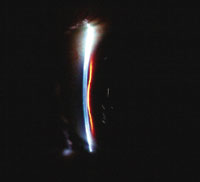Editor"s note: This month, optometrists Joseph Sowka and Alan G. Kabat take over "Therapeutic Review." Both are faculty members at Nova Southeastern University College of Optometry and are co-authors of our "Handbook of Ocular Disease Management."
 |
| Patients who have ACG present with a narrow angle and shallowing of the anterior chamber. |
Anatomically, patients with ACG have smaller eyes. Studies indicate that these patients, compared with other age-matched individuals, have axial lengths that are 5% shorter, lenses that are 7% thicker, anterior chambers that are 24% more shallow and anterior chamber volumes that are 37% less.4 The tight apposition between the posterior iris and anterior lens capsule results in pupil block, a high resistance to forward movement of aqueous through the iris-channel. Pupil block is normal and occurs in virtually every person, but in rare cases, it can become pathological and result in ACG.
Individuals who develop ACG have an increased pressure differ-ential between the anterior and posterior chambers, with resultant iris bomb and angle closure. When this increased pressure differential occurs, there is a marked bowing forward (convexity) of the iris.
Therapeutic strategies to break the ACG attack have included top-ical steroids, beta-blockers and alpha-2 adrenergic agonists. Oral medications have included Diamox (acetazolamide, Wyeth-Ayerst) and hyperosmotic solutions, such as Osmoglyn (glycerin, Alcon). And, topical miotics such as pilocarpine have long been used to relieve the relative pupil block and physically pull the iris away from the angle.
Recent findings, however, suggest that topical miotics and Diamox are not beneficial for all patients who develop ACG. Here, we will discuss these findings and how they effect these traditional management strategies.
More than Anatomy
The Chinese population has a fivefold greater prevalence of ACG, but not a fivefold incidence of small eyes, so anatomy is obviously not the only reason for ACG.3,5-8 Clearly, there are other contributory factors. One factor is choroidal expansion.3,5-8
Ultrasound biomicroscopy has clearly demonstrated choroidal expansion and shallow choroidal effusion in patients who have ACG. This expansion is associated with anterior rotation of the ciliary body and forward movement of the iris and lens, with subsequent shallowing of the anterior chamber and closure of the angle.3,5-8
Due to expansion of the choroid and ciliary body edema (with possible choroidal effusion), there is a relaxation of the lens zonules, with increased laxity and thickening of the lens. Besides ACG, there is a refractive error shift with several diopters of acquired myopia.
Several conditions, including scleritis, Vogt-Koyanagi-Harada syndrome, HIV infection and cav- ernous sinus fistula, may lead to choroidal expansion and ACG in previously normal eyes not at risk for angle closure. Panretinal photocoagulation may also be linked.
The administration of sulfa-based medications, such as sulfonamides, acetazolamide and hydro- chlorothiazide, have also been implicated.7-8 Most notably, Topamax (topiramate, Ortho-McNeil), a sulfa-based antiepileptic medication also used for chronic headaches and to induce weight loss, has been strongly implicated in choroidal expansion-induced bilateral ACG, along with induced myopia.7,8 An inflammatory allergic reaction may be the mechanism responsible for this.3
Patients who have choroidal expansion-induced ACG do not have the classic iris bomb appearance of pupil block. They have flat, shallow anterior chambers with iris-corneal apposition.
Different Treatment
Patients with choroidal expansion-induced ACG may not benefit from pilocarpine administration, because it can also induce choroidal congestion.3 Laser iridotomy has also been proven ineffective, as pupil block is not the cause of this ACG. Thus, traditional angle-closure therapy can worsen this condition.
Because sulfa-based medications can cause this form of ACG, our treatment plan must begin with determining if use of such medications precipitated ACG. If so, discontinuation of these drugs will often resolve the patient"s condition.3,5-7 If the patient acknowledges that he or she takes medication, but cannot remember the name(s), we must contact the prescribing doctor.
If the patient"s choroidal expansion is due to one of the other previously mentioned conditions, however, we should prescribe a potent cycloplegic, such as
atropine, in combination with topical steroids. Both will allow for ciliary relaxation and posterior rotation, with resolution of the angle closure.3,5-7
As practitioners, we must realize that several factors can lead to ACG. Recognizing the physiology factor is important, so that we can properly treat choroidal expansion-induced ACG patients. Proper treatment does not consist of automatically prescribing pilocarpine and Diamox. Rather, we may need to have the patient discontinue possible causative systemic medications, and prescribe potent cycloplegics and topical steroids to those patients.
1. Quigley HA. Number of people with glaucoma worldwide. Br J Ophthalmol 1996
May;80(5):389-93.
2. Foster PJ, Johnson GJ. Glaucoma in China: how big is the problem? Br J Ophthalmol 2001 Nov;85(11):1277-82.
3. Congdon NG, Friedman DS. Angle-closure glaucoma: impact, etiology, diagnosis, and treatment. Curr Opin Ophthalmol 2003 Apr;14(2):70-3.
4. Friedman DS, Gazzard G, Foster P, et al. Ultrasonographic biomicroscopy, Scheimpflug photography, and novel provocative tests in contralateral eyes of Chinese patients initially seen with acute angle closure. Arch Ophthalmol 2003 May;121(5):633-42.
5. Waheeb S, Feldman F, Velos P, Pavlin CJ. Ultrasound biomicroscopic analysis of drug-induced bilateral angle-closure glaucoma associated with supraciliary choroidal effusion. Can J Ophthalmol 2003 Jun;38(4):299-302.
6. Quigley HA, Friedman DS, Congdon NG. Possible mechanisms of primary angle closure and malignant glaucoma. J Glaucoma 2003 Apr;12(2):167-80.
7. Chen TC, Chao CW, Sorkin JA. Topiramate induced myopic shift and angle closure glaucoma. Br J Ophthalmol 2003 May;87(5):648-9.
8. Ikeda N, Ikeda T, Nagata M, Mimura O. Ciliochoroidal effusion syndrome induced by sulfa derivatives. Arch Ophthalmol 2002 Dec;120(12):1775.
Vol. No: 141:10Issue:
10/23/04

